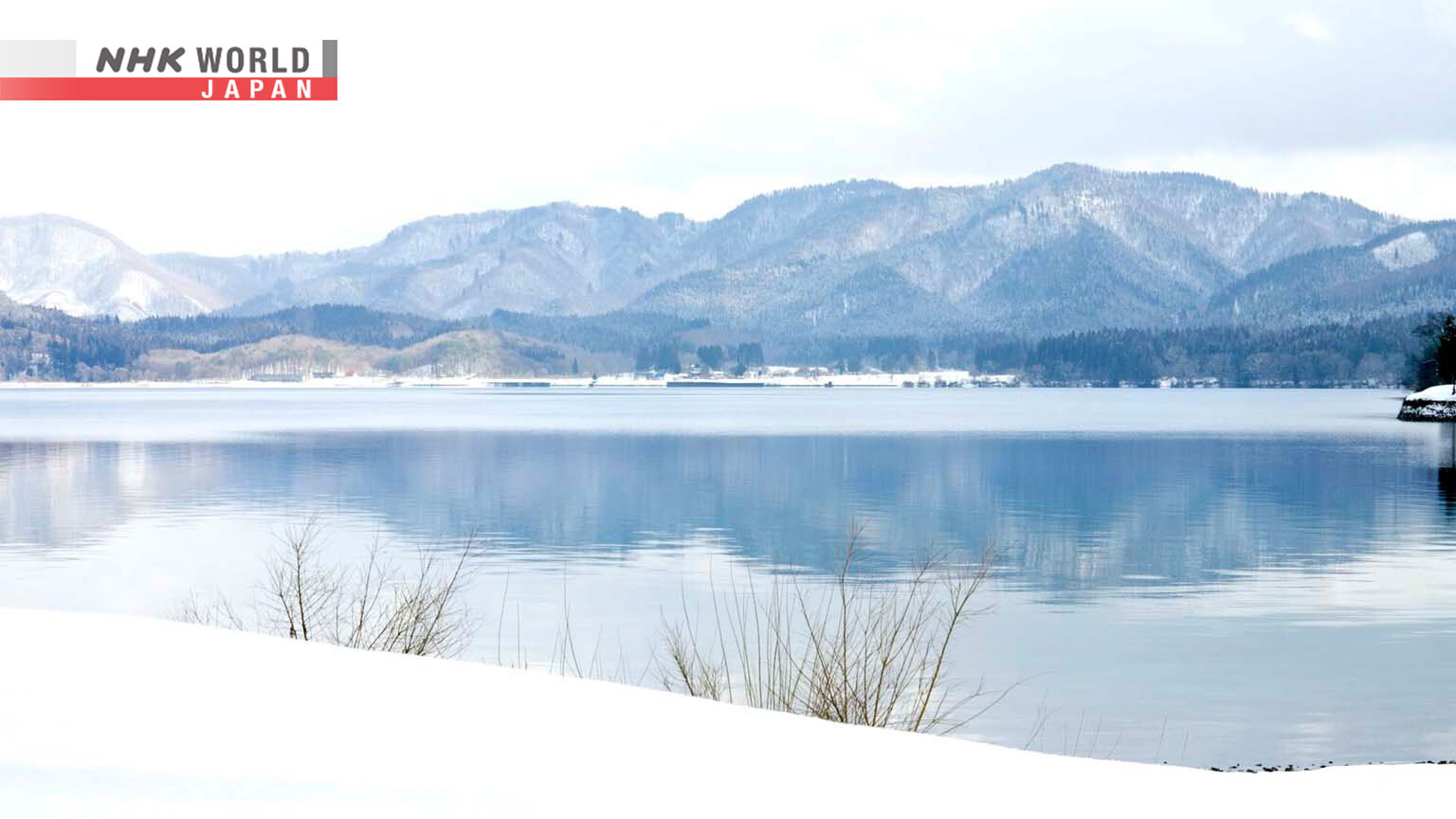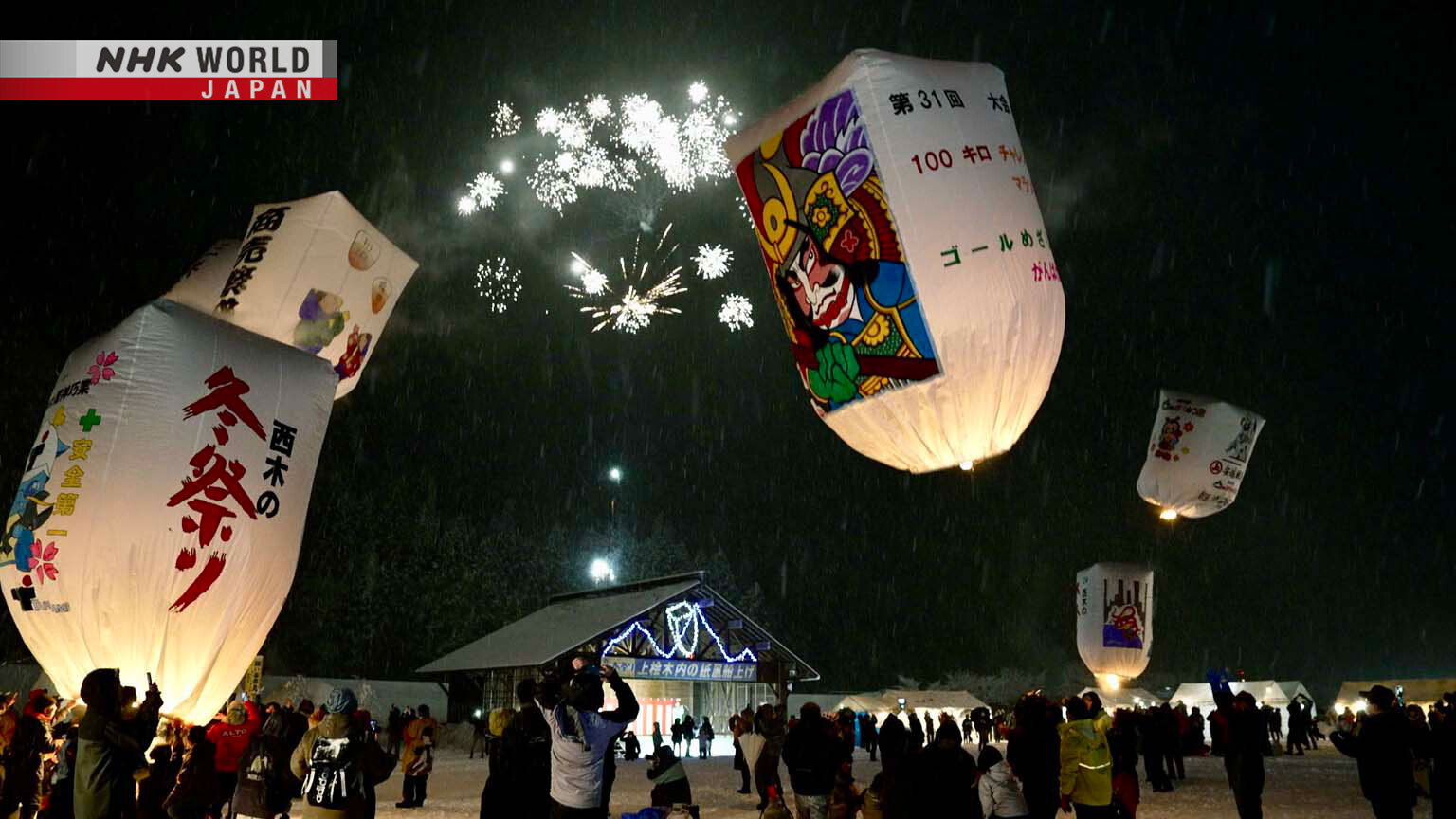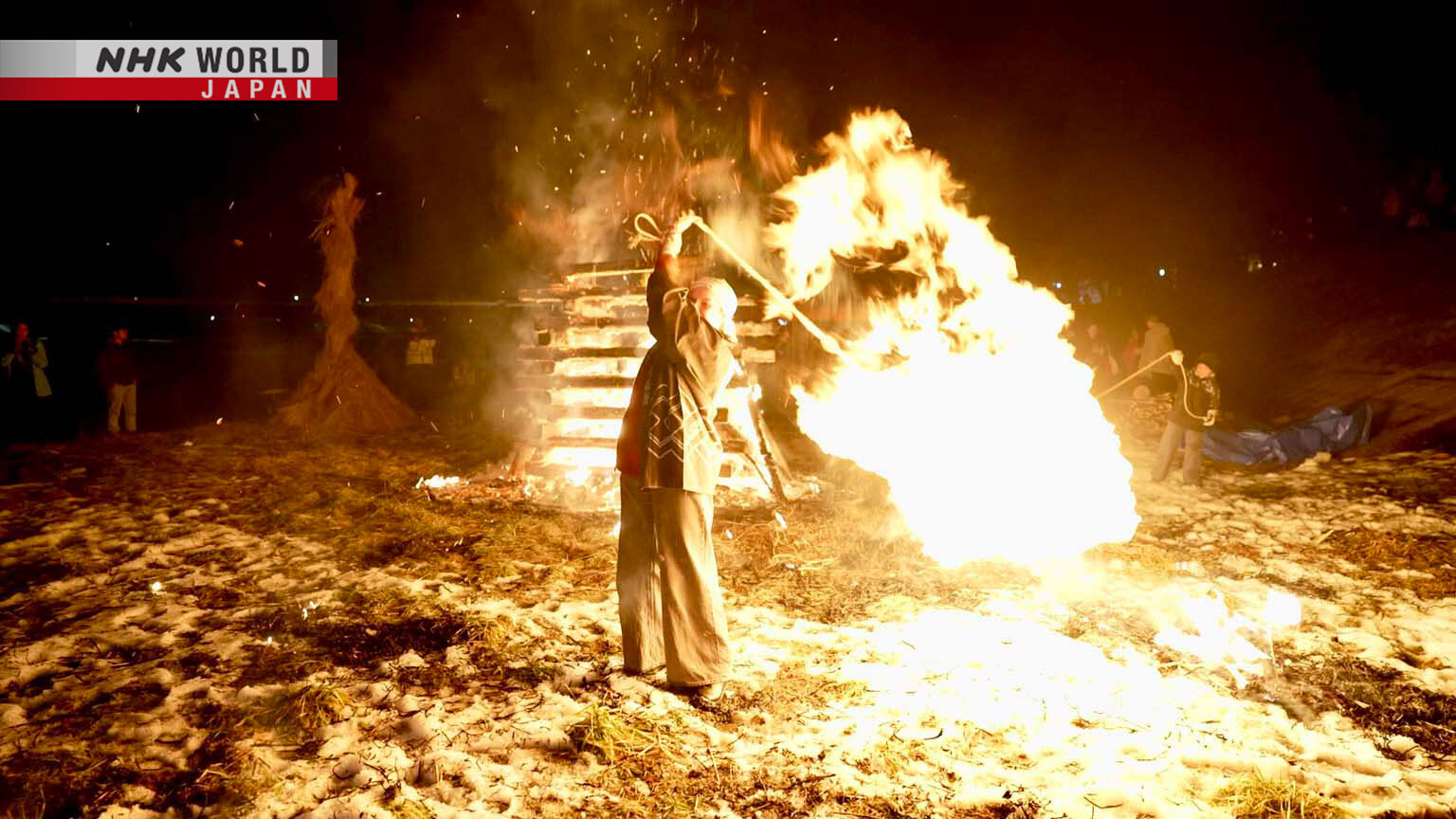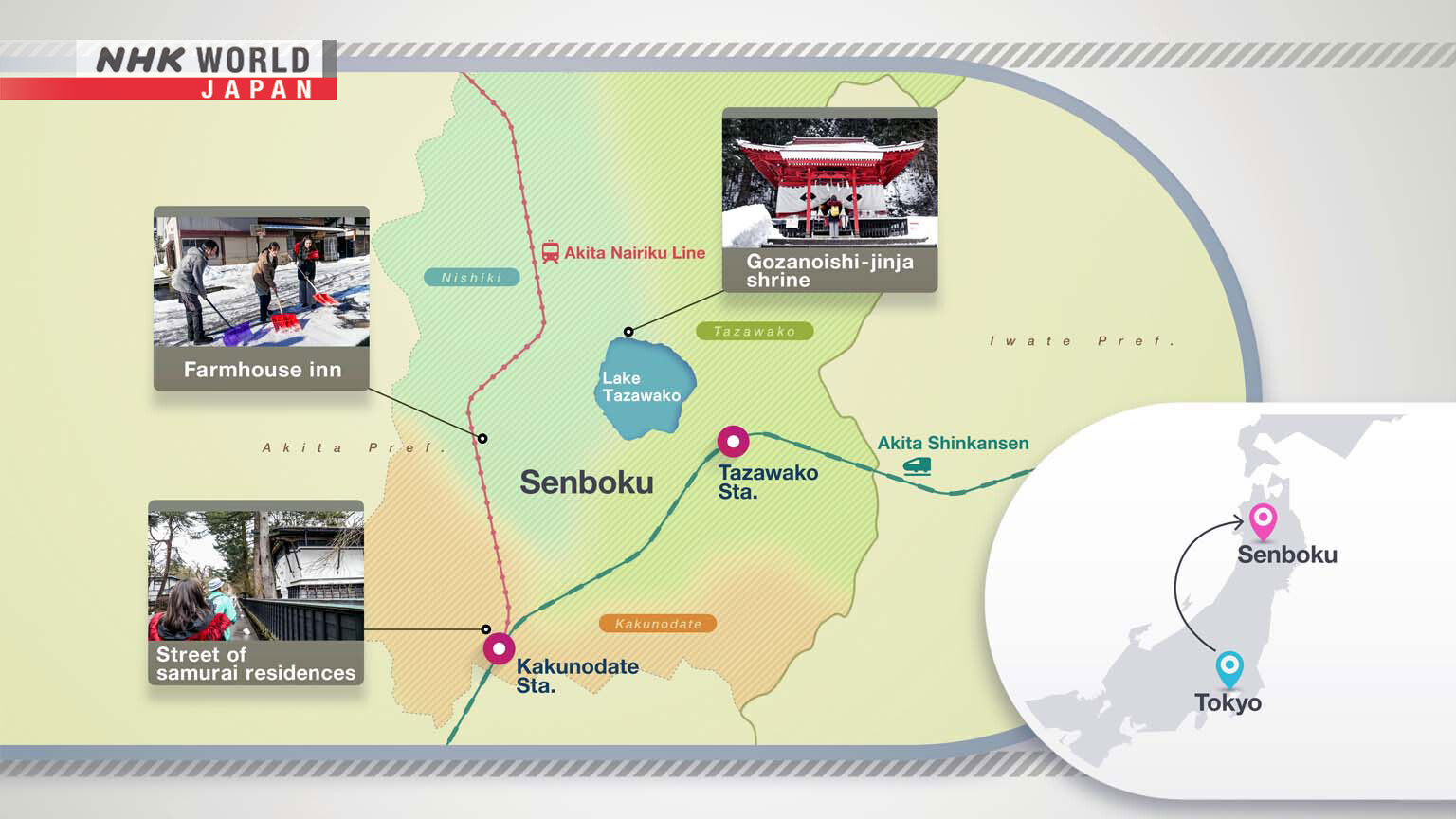Akita's Festivals Light Up Long Winters
The city of Senboku in Akita Prefecture is made up of three towns: Tazawako, which has the deepest lake in Japan; Nishiki, home to farming scenery: and Kakunodate, called the little Kyoto of Tohoku. In addition to the stunning nature and samurai culture, visitors can enjoy spectacles related to the Lunar New Year. Catrina Sugita experiences the area's winter lifestyle and its fiery festivals.
Lake Tazawako

Lake Tazawako is Japan's deepest with just over 423 meters. In winter, it doesn't freeze over, and its beautiful azure waters glisten against the range of snow-capped mountains.
Kamihinokinai Paper Balloon Festival (Nishiki)

In the Kamihinokinai district of Nishiki, a traditional event of raising huge paper balloons is held every February. Local residents spend 2 months making the paper balloons, which carry wishes for an abundant year. They are released high into the sky with the help of tourists.
Hiburi-Kamakura (Kakunodate)

Hiburi-Kamakura is a thrilling midwinter rite passed down in Kakunodate for more than 400 years. A straw sack attached to a rope is lighted, and the burning sack is swung around the holder's body. The purification ritual is a way of praying for "good health and family safety."
Access

To reach Senboku City from Tokyo, it takes about 2 hours and 50 minutes by Shinkansen to Tazawako Station.
Transcript
"Journeys in Japan"
The serenity of deep winter in Akita...
is broken on one incendiary night...
in New Year's rites on an old calendar.
They are rousing, purifying
and warming festivals shaped by the season.
Catrina Sugita, from Switzerland,
works in the travel industry.
I'm a big fan of Japanese festivals
but I've only ever experienced them during the summer,
so this year will be my first winter festival and I'm really excited.
I really wonder how the locals live their daily lives,
why they even have winter festivals in the first place,
and what kind of festivals those are.
I can't wait to find out.
On "Journeys in Japan,"
she travels to Akita to discover the snow-country lifestyle
and magical festivals.
Akita's Festivals Light Up Long Winters
The city of Senboku in Akita Prefecture
is about 450 kilometers north of Tokyo.
Forests blanket about 80 percent of Senboku,
which is made up of three towns after a merger.
Tazawako is home to Japan's deepest lake,
which shares the same name.
Then there's Nishiki, famous for its rural scenery.
And finally, Kakunodate, the charming "little Kyoto" of northern Japan.
Our journey will explore them all.
First stop, Tazawako.
(Tazawako Station)
- Hello.
- Hello.
- Is your dog an Akita?
- He is.
Hello. You are so adorable.
The breed is known for being loyal, calm and brave.
He's a big baby. See, he leans into me.
Thank you.
- Hello.
- Hello.
I'm really happy to be traveling by local bus.
You could enjoy the beautiful winter scenery
while still being nice and warm and cozy.
Oh, I think I can see the lake.
Thank you.
Lake Tazawako is about 20 kilometers in circumference.
The lake is so beautiful surrounded by these snowy mountains,
although there's definitely a kind of mysterious atmosphere
since it's snowing. You can't see all of the mountains.
It reminds me a lot of Switzerland.
- Hi, where are you from?
- I am from Korea.
Oh, Korea. How did you find out about Tazawako?
Actually, it's kind of famous in Korea
because of that Korean drama
filmed here.
They filmed a Korean drama here.
This winter-scape is attracting overseas visitors.
Is it, like, popular in Taiwan?
- Very, Very popular.
- Oh yeah?
Yes. A lot of Taiwanese have been visiting this place.
Really?
They like Akita very, very much. Yes.
That's awesome. Because it's, like, so cold.
Yeah, but because it's very warm and hot in Taiwan,
people enjoy snow here. Yeah.
The lake is home to an old legend.
A maiden in pursuit of eternal beauty transforms into a dragon.
Gozanoishi-jinja enshrines her as the dragon goddess of the lake.
Definitely feels like there's some kind of special energy here
when you're admiring the lake by
the entrance of the gate to the shrine.
Next, it's time to discover Nishiki.
(Nishiki)
When traveling, I really like to stay with locals
because it's a great way to get a peek inside their daily lives
and even experience it.
I wonder what kind of lifestyle the people here live.
Hello. I'm Catrina. Thank you for having me.
Thank you for coming.
Sasaki Hiroko runs a farm guesthouse.
She manages a grove of Saimyoji chestnut trees
which have been cultivated in Nishiki for some 300 years.
Nearly three decades ago, she opened her farm to travelers.
- Hello.
- Hello. Nice to meet you.
Her daughters help out.
Sasaki is showing efficient techniques for clearing snow,
normally massive at this time of year.
You need a lot of strength.
Amazing.
Now you try.
Oops.
They're moving the snow before it freezes.
Have you been doing this since you were little?
Yes. If we didn't, we couldn't get to school.
Really?
I can't imagine having to do this every time it snows.
Hi.
Our guest is here to help.
Incredible.
Look how big the chestnut is. It's almost as big as the palm of my hand.
The Saimyoji species of chestnuts is one of Japan's largest,
growing to the size of an egg.
I'll demonstrate.
You rotate the chestnut. You peel it like this.
I don't think I will excel at this work.
I wasn't good either.
- I'll start.
- Good.
- Hang on, this Is Very difficult.
- At first...
It might take me 30 minutes to finish.
She makes it look so easy.
It's a lot harder than I expected.
Did you do this as kids?
When I was little, I used to watch my grandmother and my mother doing this.
Mom, don't you find this work hard?
This is all we have. But it's enjoyable.
- You like it?
- Yes.
You have to enjoy your work.
Are people around here all farmers?
They used to be. Now most go out to work at companies.
Only a few farmers are left.
True. Many grow their own vegetables.
The sun has come out.
It has.
Over there...
The roof collapsed under the weight of snow.
Really?
Is someone living there?
It used to be a work shed. So, no one lived there.
Because we have heavy snow, buildings can collapse due to the weight.
That's right.
Snow can be scary... though beautiful.
It has that frightening aspect, as well.
The sisters want to share a simple pleasure.
There is a railway track. And the Nairiku Line passes by.
We wave at the train and passengers wave back.
One's coming.
It's a 2-car train.
Please notice us. Look, they are waving.
Thank you so much. You took such good care of me.
Take care.
(Kamihinokinai district)
So I'm on my way to a village that has a winter festival.
And since it's my first ever winter festival,
I'm really excited to learn everything there is about it.
I think I found it.
Ah, it smells like a Japanese festival.
It's very similar to summer festivals.
They have the food stalls with the squid.
If it weren't so cold, I'd think we were in the summer.
It's Kamihinokinai's "koshogatsu,"
meaning little New Year.
Residents raise impressive balloons made of "washi" paper
in a tradition dating to the Edo period.
They bear wishes for abundant harvests and good health.
Over the years, the balloons have, well, ballooned,
some measuring up to 12 meters in height.
The flames of gas burners heat the air inside.
Then, the balloons are released at once.
This is fun. It's great to see children having fun.
This is a festival that kids and adults can enjoy together.
We all do the balloon-making and painting, too.
Residents spend about two months
crafting the balloons by hand for the festival.
With nightfall, the real spectacle begins.
Let's all do the countdown.
10, 9, 8, 7, 6,
5, 4, 3, 2, 1.
That was so fun!
The last moment is really, really hot,
and it's quite heavy.
So it's like we're all working together, and then it's liftoff.
And it's like the hard work has paid off,
and hopefully, everyone's wishes come true.
Everyone is welcome to join in.
Just making the balloons is not enough.
People's hearts must become one, and we can act in unison.
I think this is a great aspect of the festival.
- I really felt the same.
- That's good, very good.
Will you come again next year?
(Kakunodate)
Kakunodate is a castle town established in 1620.
Many old buildings, including samurai residences,
have been preserved.
I really love all the traditional samurai residences that are here.
It feels like traveling back in time to past Japan.
- Hello.
- Hello.
Tozawa Hideki is a local guide.
Why are all the walls here black?
In the old days, high-ranking people favored black walls.
They stained the wood with persimmon tannin dye and black ink.
That protected the wood against decay.
Were there special designs for the long winters?
This year we've had little snow. We used to get 1 to 2 meters.
So, the snow piled on roofs.
Really?
People had to shovel off snow from the roof like this.
You had that much snow.
For warehouses, wooden braces were installed
to reinforce roofs against the snow's weight.
They're called "hozue,' which means
cupping your hands under your cheeks.
The tall fir trees planted around the mansion
served to reduce snow accumulation.
The high-ranking Ishiguro family managed Kakunodate's finances.
Among the samurai residences,
theirs is the oldest, around 200 years.
This is the current head of the Ishiguro family.
Ishiguro Naonobu is the 13th family head.
He still lives on the premises,
though a part is open to the public.
This is the living room. We used charcoal in the "irori" hearth.
You used charcoal.
Because it's charcoal, there was little smoke.
But over here, there was a fireplace.
Firewood was readily available, but produced smoke.
In this room, a part of the ceiling was raised.
It had a wooden window that could be opened to release the smoke.
This is a tool born from the long winters.
This is snow country. So, clothing was hung here to dry.
Smoked and other preserved foods were also hung here
to benefit from the warmth.
And there are more ingenious goods for coexisting with snow.
This is a "hakozori" box-sleigh. People used it for shopping.
And they also used it for taking young children out.
This is a "fumidawara" snow boot.
They were worn to tread paths in the snow.
This is a portable hearth.
Samurai residences like this heated rooms with such devices
fueled by charcoal, a luxury at the time.
And in winter, 3 to 4 charcoal sacks would be emptied.
Children would ask for the sacks to use in the Hiburi-Kamakura.
The Hiburi-Kamakura of Kakunodate
is a little New Year tradition passed down for more than 400 years.
Participants swing around straw bales tied to ropes
to drive away misfortune and pray for health.
It looks like they're getting ready for the festival.
Should we take a closer look?
Hello. Thanks for letting me join in.
No longer used today,
these bales are made especially for the festival.
Try to cover your hair as much as possible.
It's so hot!
I don't think I can go any closer.
They've just launched the fireworks. It's time to start!
You can do it.
Awesome!
- I want to swing it, too.
- Okay.
If you do this, you won't catch a cold for a year.
Really?
I'll do it so I won't catch a cold.
Swing it a little more slowly.
Scary.
Yikes.
It's hot.
That was scary.
Please swing it slowly.
The people in each group, they're so nice.
They tell you how to do it properly, they're supporting you,
they're cheering you on. It's such a nice atmosphere.
Swing it around slowly.
People are traveling post-pandemic.
Tourists are really up from last year.
If visitors go home with good memories they might come back.
We are a small group with only about 20 households in our district.
But we will keep up this festival.
Please go ahead. Light it.
For the climax,
all the districts' group leaders swing the fireballs
to protect the residents.
On this journey, I encountered the rich culture that
thrives in this region, its long-lasting traditions,
and its incredibly kind people.
I discovered a lifestyle where people have such strong bonds.
And they put so much care into the work that they do.
And I was blown away how so many people came together
as one at each winter festival.
I feel so lucky to have been able to experience
the traditions that have been passed down for generations here.
Despite the cold weather,
this has been such a heartwarming journey for me,
and I hope that this warmth has reached you at home too.
From Tokyo, it takes about 2 hours 50 minutes
by Shinkansen to Tazawako Station,
the gateway to Senboku City.